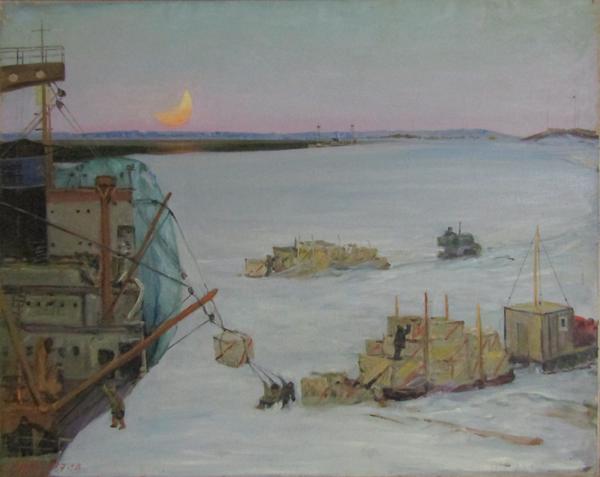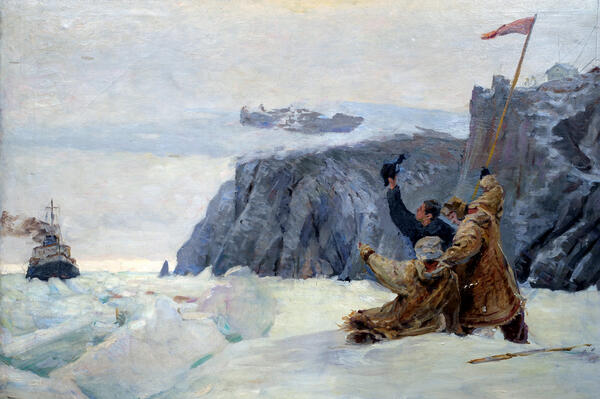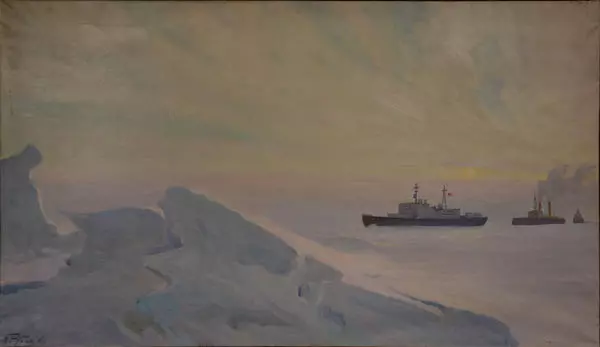Igor Pavlovich Ruban is one of a few painters, whose work centres on Arctic themes. He personally participated in numerous expeditions and produced paintings on each of the trips. Those pieces were dedicated to natural beauty of the Far North, Arctic, Antarctica and telling about the difficult life of people in these harsh lands.
Unloading was painted in 1957. In this period, the painter visited station ‘North Pole-4’ a few times, participated in the second continental Antarctic expedition and spent winter at ‘Mirny’ Observatory. The canvas depicts unloading of polar station equipment. In the left part of the painting, there is a large icebreaker ship, that transported all the things needed for life and work in the Arctic. People in warm clothing are stacking cargo on a platform, while a tractor is already towing the first freight load to the station.
An icy landscape takes up most of the canvas. The painter was able to capture the freshness of the air, transparency of the light and majestic natural beauty of this land. The mainland is visible over the horizon, with the bright, almost mandarin-coloured, Moon hanging over it. The unusual shade is by no means a product of the painter’s imagination, as the Moon in the Arctic really looks orange due to unusual refraction of light in the atmosphere.
Igor Ruban was born at Ruzaevka outpost near Penza on 12 June 1912. A grand-scale railway construction Moscow-Kazan took place in that region back then. The painter’s father participated in it. When the boy turned 8, the family moved to the capital, where Ruban graduated from school and started his studies at the studio of Ksavery Pavlovich Chemko. The young artist’s style was influenced by the works of his teachers — Dmitry Kardovsky and Igor Grabar.
In 1942, Igor Ruban graduated from Moscow Art Institute and two years later went on his first Arctic expedition. In the years that followed the artist completed numerous overland, coastal and ice-breaking routes, and kept painting his pictures everywhere. While taking part in the drift of “North Pole-4” station in 1954, he created a whole series of artworks that later he presented at his personal exhibition “40 days at the Pole”.
The art pieces, created in the challenging environment of snow and permafrost, are notable for freshness of perception and intricate play with light and texture. The painter created quite a few canvases dedicated to the history of the reclamation of the Arctic. He worked on those pieces in his studio using the collected archive materials and paying much attention to compositional choices.
Igor Ruban spent more than 40 years on journeys, where he kept creating paintings. Those artworks have become something of a chronicle of the reclamation of the Arctic and Antarctic. Igor Pavlovich’s achievements were highly regarded by his contemporaries — the painter’s personal exhibitions all over Russia were a great success. Nowadays the artist’s works are kept in the State History Museum, Tretyakov Gallery and Navy Museum. A few of his paintings are at Uzlovsky Museum of Fine Arts and Local History.
Unloading was painted in 1957. In this period, the painter visited station ‘North Pole-4’ a few times, participated in the second continental Antarctic expedition and spent winter at ‘Mirny’ Observatory. The canvas depicts unloading of polar station equipment. In the left part of the painting, there is a large icebreaker ship, that transported all the things needed for life and work in the Arctic. People in warm clothing are stacking cargo on a platform, while a tractor is already towing the first freight load to the station.
An icy landscape takes up most of the canvas. The painter was able to capture the freshness of the air, transparency of the light and majestic natural beauty of this land. The mainland is visible over the horizon, with the bright, almost mandarin-coloured, Moon hanging over it. The unusual shade is by no means a product of the painter’s imagination, as the Moon in the Arctic really looks orange due to unusual refraction of light in the atmosphere.
Igor Ruban was born at Ruzaevka outpost near Penza on 12 June 1912. A grand-scale railway construction Moscow-Kazan took place in that region back then. The painter’s father participated in it. When the boy turned 8, the family moved to the capital, where Ruban graduated from school and started his studies at the studio of Ksavery Pavlovich Chemko. The young artist’s style was influenced by the works of his teachers — Dmitry Kardovsky and Igor Grabar.
In 1942, Igor Ruban graduated from Moscow Art Institute and two years later went on his first Arctic expedition. In the years that followed the artist completed numerous overland, coastal and ice-breaking routes, and kept painting his pictures everywhere. While taking part in the drift of “North Pole-4” station in 1954, he created a whole series of artworks that later he presented at his personal exhibition “40 days at the Pole”.
The art pieces, created in the challenging environment of snow and permafrost, are notable for freshness of perception and intricate play with light and texture. The painter created quite a few canvases dedicated to the history of the reclamation of the Arctic. He worked on those pieces in his studio using the collected archive materials and paying much attention to compositional choices.
Igor Ruban spent more than 40 years on journeys, where he kept creating paintings. Those artworks have become something of a chronicle of the reclamation of the Arctic and Antarctic. Igor Pavlovich’s achievements were highly regarded by his contemporaries — the painter’s personal exhibitions all over Russia were a great success. Nowadays the artist’s works are kept in the State History Museum, Tretyakov Gallery and Navy Museum. A few of his paintings are at Uzlovsky Museum of Fine Arts and Local History.






